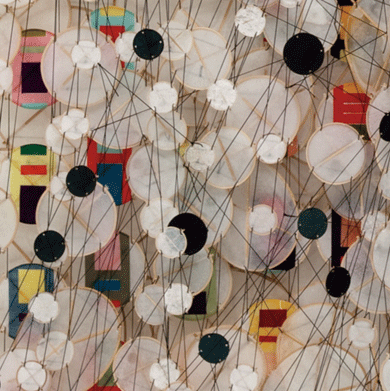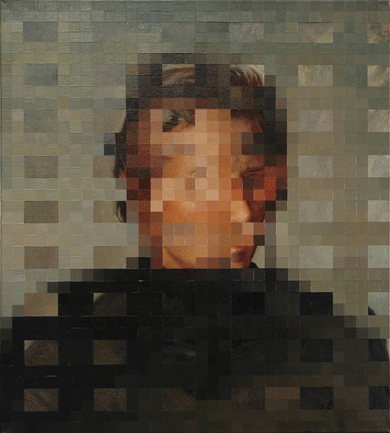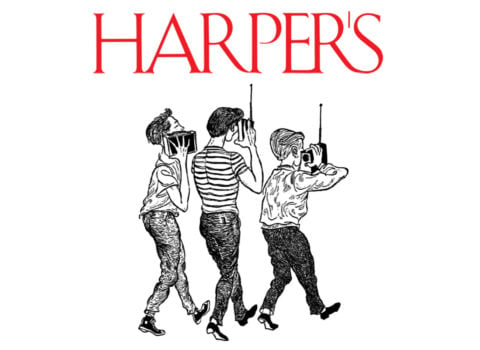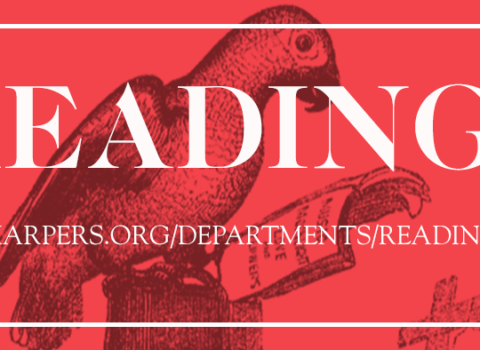First, collect all the details you can on all the people you encounter — this will turn them into “characters.” Second, search this trove for the most interesting connections among the characters — links of behavior, temperament, vocabulary, and body — because it’s connections that make a plot. Third, settle on the character with the most links to narrate the plot, or to be narrated through by an omniscient third person. This is how you write a novel. This is also how you operate an intelligence agency.
The NSA is a thoroughly “modern” organization. Its techniques are those of Kafka, who anonymized his suspects under the alias “K,” and of Nabokov, who loathed psychology, venerated artifice, and insisted that the role of the novelist was that of a “wizard” or “puppet-master.” A more direct association might be made with Joyce’s Ulysses, which so deeply surveils Leopold Bloom that he seems less a person than a welter of metadata about Dublin, June 16, 1904. In the twentieth century, form, structure — fate — became something to be imposed, not something arising out of an individual’s essential “nature.” Today, we are nothing if not characters acting out our lives for the rewriting of our intelligence minders, but what makes our predicament “postmodern” is that we’re aware of it. Confirmation has come courtesy of the journalist Glenn Greenwald and his source, the NSA contractor of conscience Edward Snowden, a character so decent that John le Carré or Frederick Forsyth would’ve blushed before conceiving him.
Greenwald’s no place to hide (Metropolitan, $27) is a hybrid, beginning as an airport thriller recounting the author’s contact with Snowden, and ending as a course text on the global amassment of digital communication. Like many thrillers, and like many course texts, it seems to be the work of a committee. Though Greenwald’s is the only name on the cover, the NSA deserves its credit, too. Almost the entire latter half of the book consists of charts and graphs made by that agency and obtained by Snowden: when it comes to PowerPoint presentations, America remains second to none.
Throughout both halves, Greenwald, a civil rights lawyer by training, invokes the First Amendment as a guarantee of his right to interpret the Fourth — the Constitution’s protection against warrantless search and seizure, adopted in response to the writs of assistance, which licensed the British to occupy and confiscate the property of colonists. A cloud born of server clusters, traffic through underwater cables and satellites in orbit — such is the contemporary condition of what that amendment so quaintly calls our “houses, papers, and effects.”
In December 2012, Greenwald — who has lived in Brazil with his partner, David Miranda, since 2004, in protest of U.S. antipathy toward same-sex marriage — receives an email from “Cincinnatus,” a cybernym, that promises vague disclosures; all Greenwald has to do is install the encryption software PGP (Pretty Good Privacy) on his laptop. But Greenwald, perpetually on deadline, blows him off. Flash forward six months: the documentary filmmaker Laura Poitras (currently finishing her trilogy about post-9/11 America) conscripts Greenwald to meet an NSA leaker in Hong Kong. Together, they follow the slapstick tradecraft instructions: Go to the Mira Hotel, locate a conference room festooned with a green plastic alligator, and ask a staff member the pass-question “Is there a restaurant open?” Et voilà — a gawky postadolescent materializes, fussing with a Rubik’s Cube, the identifying prop.

On a Pitch Black Lake (detail), by Jacob Hashimoto. Courtesy the artist and Martha Otero Gallery, Los Angeles
Up in Snowden’s room — where noodle containers have mounted and pillows are pressed against the under-door draft — Greenwald vets Snowden and goes through the exfiltrated files. He returns to his own room at the nearby W Hotel only to summarize the files in dispatches sent to the Guardian (the U.S. Guardian, as the British Guardian is constrained from publishing material deemed vital to U.K. security — later, in an attempt at intimidation, Government Communications Headquarters forced the British paper’s editors to destroy their own hard drives). While still in Hong Kong, Greenwald exposes a series of orders by the U.S. Foreign Intelligence Surveillance Court compelling telecoms to turn over call logs; PRISM, a program for the bulk collection of all email, voice, text, and video-chat communications routed through the servers of Google, Microsoft, Apple, Yahoo, et al.; and BOUNDLESS INFORMANT, a tool that generates “heatmaps” of the metadata captured by PRISM.
Finally — Greenwald breathes:
After the “BOUNDLESS INFORMANT” article was published, Laura and I planned to meet at Snowden’s hotel. But before leaving my room, out of nowhere, as I sat on my hotel bed, I remembered Cincinnatus, my anonymous email correspondent from six months earlier, who had bombarded me with requests to install PGP so that he could provide me with important information. Amid the excitement of everything that was happening, I thought that perhaps he, too, had an important story to give me. Unable to remember his email name, I finally located one of his old messages by searching for keywords.
“Hey: good news,” I wrote to him. “I know it took me a while, but I’m finally using PGP email. So I’m ready to talk any time if you’re still interested.” I hit “send.”
Soon after I arrived at his room, Snowden said, with more than a small trace of mockery, “By the way, that Cincinnatus you just emailed, that’s me.”
This is a humorous and humanizing update of a James Bond bromance. And, like the best of those, it imparts a sense of the relationship’s cultural disparity — between the intelligence analyst and the civilian citizen, between the Fifth Estate of tech and the Fourth Estate of journalism. In every instance, the side with more intel can’t help but treat the other with “more than a small trace of mockery.”
After describing Greenwald’s return to Brazil, and the online debut of the Poitras-filmed clip in which Snowden outed himself to the world — incriminating himself in a bid to explain and to obtain public support — the book turns to slides of the spying programs and protocols. Someone in Fort Meade has caps lock stuck. PROJECT BULLRUN, EGOTISTICALGIRAFFE, MUSCULAR, OAKSTAR, STEELKNIGHT, SILVERZEPHYR — they’re like the names of losing racehorses, or midlife-crisis yachts. The point is this: Everything we say on phones and write in emails is being monitored, stored, and parsed. Though that power has been abused in approximately 3,000 cases in a one-year period — often by NSA employees gathering LOVEINT on their exes — it’s not the capacity for abuse as much as it is the NSA’s exemption from reporting it and immunity from being prosecuted for it that constitutes the greatest argument against bulk collection. The greatest argument, that is, after the Constitution.
Snowden could easily have set up his own WikiLeaks-style website. Instead, he has chosen to hold our free-speech institutions to account. The Guardian, the New York Times, and the Washington Post — all have reported on Snowden’s cache and in consultation with the NSA redacted specifics that could endanger active agents. The highest task of the critic is not to condemn but to correct, and this is what Snowden has done. He has excoriated the surveillance state, but by doing so he has elevated journalism.
State espionage was initially inflicted on a limited demographic: the Privy Council spied on the British court, the Venetian doge on diplomatic and ecclesiastical circles. But when spying became surveillance — the word is seventeenth-century French, and was in common parlance by the time of the French Revolution — the dragnet was cast beyond the elite. John C. Rule and Ben S. Trotter’s A World of Paper: Louis XIV, Colbert de Torcy, and the Rise of the Information State (McGill-Queen’s University Press, $49.95) investigates this shift, which was implemented by the new intelligence bureaucracy.
Louis XIV — le roi-soleil to posterity, but also le roi-bureaucrate — ruled France and Navarre for more than seven decades, fought five wars abroad, and outlived his three immediate heirs. He also had at least three Colberts: Jean-Baptiste, his controller general of finances; Jean-Baptiste’s brother, Charles, his foreign minister; and Charles’s son, Jean-Baptiste Colbert, marquis de Torcy, who inherited his father’s position in 1696. To the east were the fractious fiefdoms of the Holy Roman Empire; to the west, Spain was under the reign of a mentally handicapped Hapsburg. Torcy, whose education was in law, negotiated the treaties that ended the wars of succession, established a centralized intelligence archive in the Louvre, and reorganized his staff from division by geography (Switzerland, Venice) to division by function (propaganda, censorship). He also controlled the mail.
Torcy required that each of the leaseholders who managed France’s postal routes appoint a contractor-director — the Booz Allen Hamiltonians of the time — who would serve at the marquis’s pleasure, monitoring his watch lists of addresses and names:
Most provincial correspondence passed through Paris for what the leaseholders claimed were financial reasons, facilitating centralized surveillance, although provincial post officers could be enlisted if needed. The Cabinet noir, in an annex to the central post office, was extensive and well organized and quickly gained notoriety for secrecy and subterfuge. Letters were opened, copied, deciphered, resealed, and sent on their way, which could cause noticeable delays.
It’s telling that Matthew Prior, Britain’s unofficial ambassador to France, felt compelled to inform the Earl of Portland, “I wrote no plainer, because I take it for granted that all my letters are broke open.” Elisabeth Charlotte of Bavaria, the wife of Louis XIV’s brother, warned her German cousins that just because
letters are properly sealed does not mean anything; they have a material made of mercury and other stuff that can be pressed onto a seal, where it takes on the shape of the seal . . . After they have read and copied the letters, they neatly reseal them and no one can see that they have been opened.
It’s the mercury and the manuscripture, the copying by hand, that bring a mystical, alchemical, and ultimately religious pall to the proceedings. As went the Church into the Dark Ages, so went the nation-state into the Enlightenment. Both became hermetic societies of copyists and clerks who, in an attempt to safeguard the faithful, monitored the faithful’s reading and behavior instead.
Paul Otlet was a Belgian bibliologist pacifist with a prophet’s beard who founded the field of information science, which he called “documentation.” Born in 1868, he was a one-man analog Google, with schemes to gather all the world’s information and organize it for universal accessibility. Alex Wright’s cataloging the world: paul otlet and the birth of the information age (Oxford University Press, $27.95) is the first English-language biography of Otlet, and it tells of Otlet’s development, with Henri La Fontaine, of the Universal Decimal Classification; his founding of the Palais Mondial (subsequently called the Mundaneum), a collection of 15 million index cards that sought to catalogue and cross-reference all books, periodicals, and recordings; and his plan to design a réseau mondial, “a worldwide network,” for their unfettered distribution.
In Otlet’s own words:
Everything in the universe, and everything of man, would be registered at a distance as it was produced. In this way a moving image of the world will be established, a true mirror of his memory. From a distance, everyone will be able to read text, enlarged and limited to the desired subject, projected on an individual screen. In this way, everyone from his armchair will be able to contemplate creation in whole or in certain parts.
Scoff at the late senator Ted Stevens’s assertion that the Internet is “a series of tubes,” but it jibes with Otlet’s proposal — as Wright tells us, “twenty-five years before the first microchip, forty years before the first personal computer” — for a web of equator-length telephone lines connected to telescopes focused on microfiche. Unlike Stevens, however, Otlet faced more than just meme scorn: the Nazi librarian Hugo Krüß supervised the dismantling of his card catalogue in 1940. Otlet died four years later, heartbroken and broke.

Don Quixote and Sancho Panza, by Honoré Daumier © Private Collection/Album/Art Resource, New York City
Cataloging the World discerns the origins of Otlet’s theme — how qualities can be made legible through quantification — in the taxonomies of the encyclopedia, the invention of artificial languages, and the transfinite numbering systems of bibliography — in, that is, seventeenth-century rationalism. Around the same time, a novel type of writing appeared — the novel, whose fictional prose consisted of eavesdropping, recounted hearsay, and purloined letters. Don Quixote, regarded as the first of the genre, features a character struggling, loving, and dying, all the while conscious that he’s being written about. The power dynamic here, however, is one in which the pitiful author cannot create, but can only witness, the scenes. On his deathbed, Quixote begs forgiveness of the author for having caused “so many and such monstrous absurdities . . . for I am leaving the world with a feeling of compunction at having provoked him to write them.”






























































































